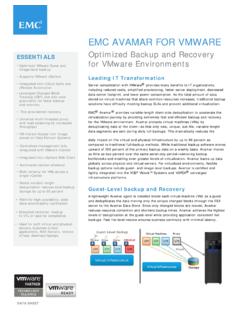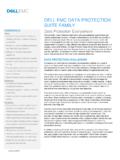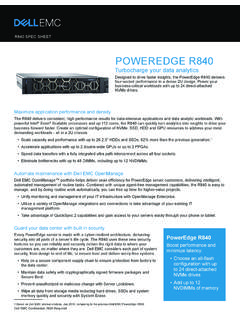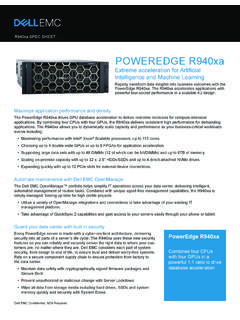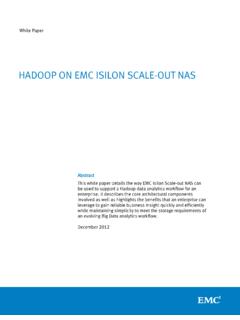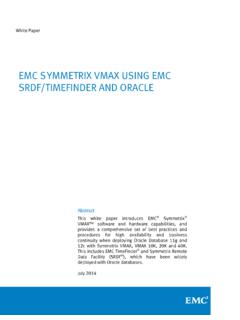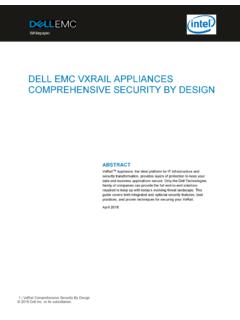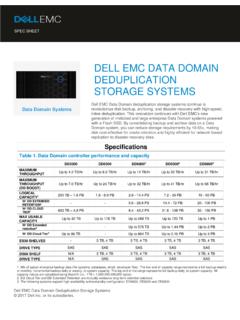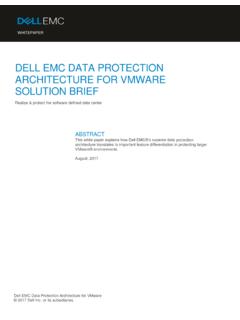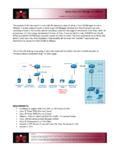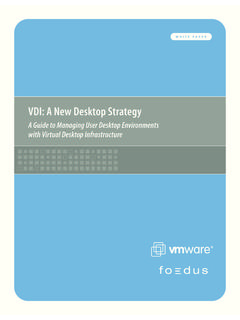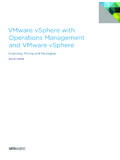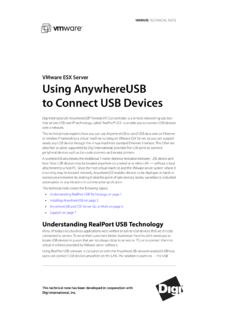Transcription of H13348 EMC VPLEX AND VMWARE TECHNICAL …
1 Abstract This TECHNICAL advisory provides information about deploying VMWARE Applications within VPLEX Metro Environments. In particular, details for the proper configuration of VPLEX Witness and VPLEX site preference rules are provided. EMC VPLEX AND VMWARE TECHNICAL CONTINUOUS AVAILABILITY FAILURE HANDLING TECHNICAL Advisory Copyright 2014 EMC Corporation. All Rights Reserved. EMC believes the information in this publication is accurate of its publication date. The information is subject to change without notice. The information in this publication is provided as is . EMC Corporation makes no representations or warranties of any kind with respect to the information in this publication, and specifically disclaims implied warranties of merchantability or fitness for a particular purpose. Use, copying, and distribution of any EMC software described in this publication requires an applicable software license. For the most up-to-date listing of EMC product names, see EMC Corporation Trademarks on All other trademarks used herein are the property of their respective owners.
2 Part Number: H13348 Table of Contents Support Statement .. 4 Audience .. 4 Solution Architecture .. 5 What is VPLEX Metro? .. 5 What is vSphere Metro Storage Cluster? .. 6 VPLEX Witness .. 6 Configuration Requirements .. 7 VPLEX Metro Failure Scenarios without VPLEX Witness .. 8 Site Preference Rules .. 8 Site Preference Rule Choices .. 8 VPLEX Metro Failure Scenarios with VPLEX Witness .. 11 VPLEX Witness .. 11 Support Statement For the most up to date information on VPLEX Metro and the applications it supports, please refer to the VPLEX EMC Simple Support Matrix located on This TECHNICAL playbook is based on the systems architecture with EMC VPLEX Metro, VMWARE HA and vMotion. It is also outlined in the VMWARE KB Using VPLEX Metro with VMWARE HA (1026692). Audience EMC Pre-Sales Organization for outlining and describing the architecture for their customers prior to purchase. EMC Global Services Application Support for effectively introducing the product into the environment and assuring that the implementation is specifically oriented to the customers needs and negates any possible DU/DL and/or application failure or misunderstanding of such failures.
3 EMC customers interested in deploying VPLEX or have deployed VPLEX and need a solid understanding of how VPLEX Metro, VPLEX Witness and VMWARE applications co-exist. EMC Support reference when issues do get reported, so that they can be quickly triaged under normal conditions as described in the TECHNICAL playbook. Solution Architecture For this TECHNICAL playbook, the goal is to review the VMWARE applications using the VPLEX Metro, the behaviors and interaction of these layered stretched environments. Figure A. VPLEX Metro with VMWARE Architecture What is VPLEX Metro? EMC VPLEX Metro is a virtual storage solution that provides simultaneous access to block storage devices at two geographically separate sites. One or more VPLEX Distributed Virtual Volumes can enable shared block storage access between the two or more clustered ESXi hosts. These volumes can be used as Raw Device Mapping (RDM) disks or as a shared VMFS datastore.
4 The RDM can be used for exclusive access by the virtual machine and the VMFS datastore can contain virtual machines and/or be used for carving out additional vDisks. The VPLEX Metro hardware at each site is designed to be highly available. A VPLEX cluster can scale from two directors to eight directors per site. Each VPLEX director is protected by redundant power supplies, fans, and interconnects, providing a highly resilient block storage environment. What is vSphere Metro Storage Cluster? vSphere Metro Storage Cluster (vMSC) is an VMWARE cluster with ESXi hosts separated across two data centers with up to 10ms RTT latency between them. VPLEX Metro has been certified using the standard VMWARE MSC certification process. VPLEX Metro is listed on the VMWARE Storage Compatibility Guide. VPLEX Witness VPLEX Witness is a VPLEX component provisioned as a virtual machine on an ESXi host that is deployed at a third site or third fault domain.
5 Deploying a VPLEX Metro Solution with VPLEX Witness gives continuous availability to the storage volumes in case of a site failure or dual WAN link failure. When a VPLEX Distributed Virtual Volume is provisioned, a per-volume preferred (winning) site flag is enabled. Distributed Virtual Volumes with the same preferred site settings may be placed in the same consistency group. The site or fault domain which runs a virtual machine and the preferred site rule of the VPLEX Distributed Volume(s) that contain the virtual machine must be aligned to ensure uninterrupted operation during WAN failures. The site preference criteria can be based on things like the availability, presence of monitoring staff, or geographic location. VPLEX Witness failure handling semantics apply only to the Distributed Virtual Volumes within a consistency group. Configuration Requirements These requirements must be satisfied to support this configuration: The maximum round trip latency on both the IP network and the inter-cluster network between the two VPLEX clusters must not exceed 5 milliseconds round-trip-time for a non-uniform host access configuration and must not exceed 1 millisecond round-trip-time for a uniform host access configuration.
6 The IP network supports the VMWARE ESXi hosts and the VPLEX Management Console. The interface between two VPLEX clusters can be Fibre Channel or IP. Round-trip-time for a non-uniform host access configuration is now supported up to 10 milliseconds for VPLEX GeoSynchrony and ESXi with NMP and PowerPath. For detailed supported configuration, see the latest VPLEX EMC Simple Support Matrix (ESSM) on The ESXi hosts in both data centers must have a private network on the same IP subnet and broadcast domain. Any IP subnet used by the virtual machine that resides on it must be accessible from ESXi hosts in both data centers. This requirement is important so that clients accessing virtual machines running on ESXi hosts on both sides are able to function smoothly upon any VMWARE HA triggered virtual machine restart events. The data storage locations, including the boot device used by the virtual machines, must be active and accessible from ESXi hosts in both data centers. vCenter Server must be able to connect to ESXi hosts in both data centers.
7 The VMWARE datastore for the virtual machines running in the ESX Cluster are provisioned on Distributed Virtual Volumes. The maximum number of hosts in the HA cluster must not exceed 32 hosts. The configuration option auto-resume for VPLEX Cross-Connect consistency groups must be set to true. Notes: The ESXi hosts forming the VMWARE HA cluster can be distributed on two sites. HA Clusters can start a virtual machine on the surviving ESXi host, and the ESXi host access the Distributed Virtual Volume through storage path at its site. VPLEX and above and ESXi are tested in this configuration with the VPLEX Witness. For any additional requirement for VPLEX Distributed Virtual Volumes, see the EMC VPLEX best practices document. VPLEX Metro Failure Scenarios without VPLEX Witness Site Preference Rules VPLEX Metro uses the site preference rules set on each VPLEX Distributed Device to make a determination about where I/O will continue during a dual wan partition event.
8 From a VMWARE administrative perspective this is very important as it will determine which ESXi servers are able to access datastore during a dual WAN partition event. Virtual machines that are running at Site-A should reside on VPLEX volumes with a preference rule set to Winner A. Similarly, virtual machines running at Site-B should reside on VPLEX volumes with a preference rule set to Site-B. Groups of virtual machines that depend on one another should reside on VPLEX virtual volumes that are combined into a VPLEX consistency group to ensure that I/O to datastores for the entire set of virtual machine continues at the same site. Site Preference Rule Choices o Winner A meaning all distributed virtual volumes with Site-A preferred will continue to service IO during a dual WAN partition or during loss of Site B. o Winner B meaning all distributed virtual volumes with Site-A preferred will continue to service IO during a dual WAN partition or during loss of Site A.
9 O No automatic winner this option exists for customers who want to manually resume their IO after dual WAN partition or site loss (uncommon setting)1 1 Some applications have legal and/or fiduciary requirements to always have two copies of data. In this case, setting no automatic winner is appropriate. No VPLEX Witness -- Site Behaviors Scenario Rule VPLEX Behavior Dual WAN Partition Winner A Dual WAN Partition Winner B Dual WAN Partition No Winner Site-A Fails Winner A Site-A Fails Winner B Site-A Fails No Winner Site-B Scenarios are similar to the Site-A: If Site-B is preferred and it fails, both sites are down. If Site-B is preferred and Site-A fails Site-B stays online. When No Automatic Winner is set when either Site-A or Site-B fails the remaining site will suspend I/O. VPLEX Metro Failure Scenarios with VPLEX Witness VPLEX Witness VPLEX Witness is a VPLEX component provisioned as a virtual machine on an ESXi host that is deployed at a third site or third fault domain.
10 VPLEX Witness provides intelligent guidance to each VPLEX cluster to enable the cluster to make a distinction between a site failure and a dual wan partition. If a site failure is identified, VPLEX Witness will guide the surviving site to override the site preference rules and, thereby, allow I/O to automatically continue at the surviving site. Only virtual volumes that are members of a consistency group with a winner rule set will receive the added protection of VPLEX Witness. VPLEX Witness I/O Continuation Behavior Scenario Rule VPLEX Behavior Dual WAN Partition Winner A Dual WAN Partition Winner B Dual WAN Partition No Winner Site-A Fails Winner A Site-A Fails Winner B Site-A Fails No Winner Site-B Fails Winner A Site-B Fails Winner B Site-B Fails No Winner Site Specific and Single Component Failures Scenario VPLEX Behavior Observed Impact Single VPLEX BE path failure VPLEX continues to operate using an alternate path to the same BE Array.
